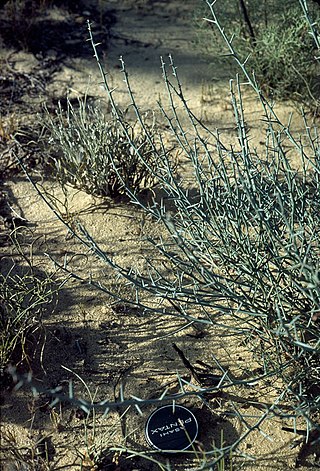
Daviesia ulicifolia, commonly known as gorse bitter-pea, is a species of flowering plant in the family Fabaceae and is endemic to south-eastern Australia. It is a rigid, openly-branched shrub with sharply-pointed, narrow elliptic, narrow egg-shaped, rarely egg-shaped phyllodes and usually orange-yellow and dark red flowers.

Daviesia divaricata, commonly known as marno, is a species of flowering plant in the family Fabaceae and is endemic to the south-west of Western Australia. It is a low, spreading or erect and bushy shrub with phyllodes reduced to small, triangular scales, and orange and maroon flowers.

Daviesia mimosoides, commonly known as blunt-leaf bitter-pea, narrow-leaf bitter pea or leafy bitter-pea, is a species of flowering plant in the family Fabaceae and is endemic to eastern continental Australia. It is an open shrub with tapering, linear, elliptic or egg-shaped phyllodes, and groups of orange-yellow and dark brownish-red to maroon flowers.

Daviesia hakeoides is a species of flowering plant in the family Fabaceae and is endemic to the south-west of Western Australia. It is a shrub with many tangled stems, scattered sharply-pointed phyllodes and yellow or orange and dark red flowers.

Daviesia acicularis, commonly known as sharp bitter-pea, is a species of flowering plant in the family Fabaceae and is endemic to eastern Australia. It is a small, wiry shrub with tapering, linear phyllodes, and single yellow to orange and dark red flowers.

Daviesia arenaria, commonly known as sandhill bitter-pea, is a species of flowering plant in the family Fabaceae and is endemic to south-eastern continental Australia. It is usually a hummock-forming shrub with many short, spiny branchlets and heart-shaped to elliptic phyllodes with a sharp point on the end, and orange-pink, maroon and yellow flowers.

Daviesia asperula is a species of flowering plant in the family Fabaceae and is endemic to South Australia. It is a compact or spreading shrub with often crowded, flattened, tapering or curved, sharply pointed phyllodes, and orange-yellow and red flowers.
Daviesia benthamii is a species of flowering plant in the family Fabaceae and is endemic to the west of Western Australia. It is an erect, bushy shrub with scattered, cylindrical, sharply pointed phyllodes, and yellow-orange and reddish-brown flowers.

Daviesia debilior is a species of flowering plant in the family Fabaceae and is endemic to the south-west of Western Australia. It is a shrub with low-lying stems and many erect branchlets, scattered linear to scale-like phyllodes, and yellow, purplish, orange-pink and dark purplish flowers.

Daviesia decurrens, commonly known as prickly bitter-pea, is a species of flowering plant in the family Fabaceae and is endemic to the south-west of Western Australia. It is spreading, erect, or low-lying shrub with scattered, sharply-pointed, narrow triangular phyllodes, and yellowish pink and velvety red flowers.

Daviesia devito is a species of flowering plant in the family Fabaceae, endemic to south-eastern continental Australia. It is a dense, prickly shrub with sharply-pointed phyllodes and yellow, red, greenish and maroon flowers. It was previously known as Daviesia benthamii subsp. humilis until that subspecies was split into two new species.

Daviesia elongata is a species of flowering plant in the family Fabaceae and is endemic to the south-west of Western Australia. It is a glabrous, spreading or sprawling shrub with narrowly egg-shaped to linear phyllodes and yellow-orange and maroon flowers.
Daviesia eremaea is a species of flowering plant in the family Fabaceae and is endemic to central Australia. It is an erect, glabrous, multi-stemmed shrub with needle-like, more or less sharply-pointed phyllodes, and yellow and red flowers.
Daviesia filipes is a species of flowering plant in the family Fabaceae and is endemic to Queensland. It is a shrub with hairy foliage, crowded, narrowly oblong phyllodes, and yellow and maroon flowers.

Daviesia glossosema, commonly known as maroon-flowered daviesia, is a species of flowering plant in the family Fabaceae and is endemic to a restricted area of south-western Western Australia. It is an erect shrub with tangled, spreading branches, cylindrical, sharply-pointed phyllodes, and unusually-shaped maroon flowers.

Daviesia incrassata is a species of flowering plant in the family Fabaceae and is endemic to the south-west of Western Australia. It is an erect, mounded to spreading shrub with more or less zigzag branchlets, scattered needle-shaped phyllodes and orange, deep red and pink flowers.

Daviesia intricata is a species of flowering plant in the family Fabaceae and is endemic to the south-west of Western Australia. It is a glabrous shrub with densely tangled branches, sharply-pointed, needle-shaped or flattened phyllodes and apricot-yellow and dark red flowers.

Daviesia sarissa is a species of flowering plant in the family Fabaceae and is endemic to inland areas of south-western Western Australia. It is a spreading or sprawling, glaucous shrub with scattered, long, rigid, cylindrical, sharply-pointed phyllodes, and orange-yellow and red flowers.

Daviesia suaveolens is a species of flowering plant in the family Fabaceae and is endemic to south-eastern New South Wales. It is a tree-like shrub or small tree with scattered, narrowly egg-shaped phyllodes with the narrower end towards the base, and yellow flowers, sometimes with faint red markings.
Daviesia subulata is a species of flowering plant in the family Fabaceae and is endemic to a restricted area in the south-west of Western Australia. It is a dense shrub with vertically flattened, sharply pointed phyllodes and yellow and red flowers.















